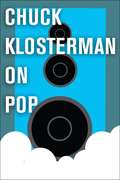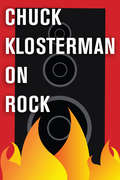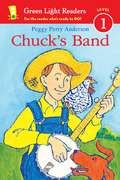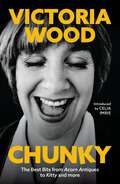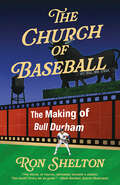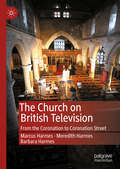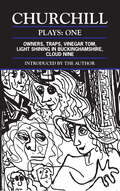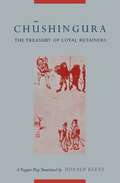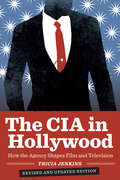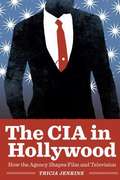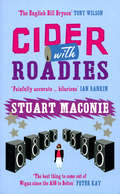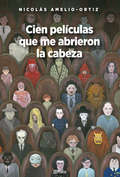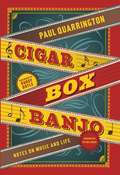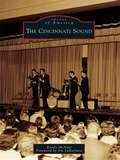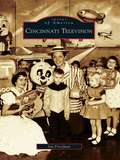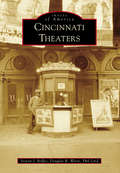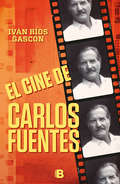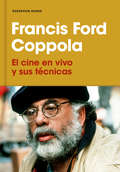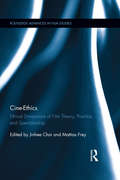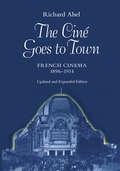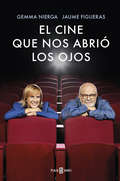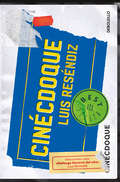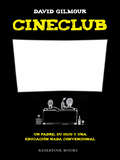- Table View
- List View
Chuck Klosterman on Pop
by Chuck KlostermanFrom Sex, Drugs, and Cocoa Puffs; Chuck Klosterman IV; and Eating the Dinosaur, these essays are now available in this ebook collection for fans of Klosterman's writing on pop music.
Chuck Klosterman on Rock
by Chuck KlostermanFrom Fargo Rock City; Sex, Drugs, and Cocoa Puffs; Chuck Klosterman IV; and Eating the Dinosaur, these essays are now available in this ebook collection for fans of Klosterman's writing on rock music.
Chuck's Band (Green Light Readers Level 1)
by Peggy Perry AndersonChuck and his barnyard friends are having a jam session and beginning readers are invited for a toe-tapping, knee-slapping good time. But what is the matter with Fat Cat Pat? Does she want her own musical instrument too, or is something else making that cat blue? Readers will have fun finding out in this perfectly pitched story! Full of rhyme, repetition, and musical instruments galore.
Chunky: The Best Bits from Acorn Antiques to Kitty and more
by Victoria Wood'Absolutely perfect. All Christmas presents sorted. No notes.' Sarra ManningBabs (on telephone): Acorn Antiques, can I help you? Gainsborough's Blue Boy? Yes, I think we have it in mauve, I'll just check.Flips over blank bits of paper.Yes, we do; shall I pop it under the counter for you? Not at all, bye!Chunky contains the complete scripts of Wood's beloved wobbly-walled spoof soap opera Acorn Antiques, as well as the Kitty monologues: 'My name's Kitty. I've had a boob off and I can't stomach whelks so that's me for you.'It also features daytime television presenters Margery and Joan, Susie the waspish Continuity Announcer, and the unforgettable bus stop stories of Kelly-Marie Tunstall: 'I said I'll tell everyone what happened on Christmas Eve when you drank two pints of correcting fluid and sexually harassed me with an outsize party squeaker'.Published to mark the 70th anniversary of Victoria Wood's birth, this stunning revised edition of Chunky collects the very best of Wood's sketches, shows and more featuring:NEW introduction from Celia Imrie, star of many of Victoria Wood's showsAdditions and annotations from Wood's acclaimed official biographer, Jasper Rees.This is a true celebration of an inimitable and greatly missed comedic genius.'I was very proud to be part of her gang.' Celia Imrie'There was none like her before and there's been none like her since - she was unique.' Dawn French'She is on a par with Alan Bennett.' Clive James
The Church Cantatas of J. S. Bach
by Alec RobertsonFor nearly every Sunday from 1723 to 1728, J S Bach composed and his young orphan boy-students performed, a half-hour cantata in the Lutheran church services of the Saint Thomas Church in Leipzig, Germany. A cantata usually began with a chorus, contained recitatives (narrative) and arias (meditations) and closed with a hymn (chorale). Bach's cantatas contain more than 1500 movements, filling 67 compact discs in today's recordings. They contain dozens of magnificent choruses and hundreds of deeply-felt and spectacular arias and chorales. Alec Robertson analyzes 173 of Bach's roughly 210 extant cantatas. He organizes them according to the Lutheran church year, starting with Advent and ending with the Reformation Festival of October 30. He introduces each Sunday and feast day with the Biblical citations which were usually the basis for the cantatas. He discusses each movement, even listing the instrumentation. Bach's cantatas are at the pinnacle of western classical music. Not only do they give spiritual nourishment to Christians and non-Christians but they are studied the world over by amateur and professional musicians for their penetrating pictorialization, harmonizations, counterpoint and beautiful melodies. They contain great choruses, arias for all types of singers, plus some duets and trios. Whether you are an amateur or serious musician, this book will help you to understand and appreciate these works. Cantatas not discussed in this book are those intended for special occasions such as weddings, funerals, birthdays of prominent persons, civic events such as town council inaugurations, those with secular themes and those originally included in the Bach canon but which modern scholarship has determined not to have been his compositions (de-established). Accordingly, the following cantatas are not discussed: 11, 15 (deest.), 29, 50, 53 (deest), 54, 71, 97, 106, 117, 118, 119, 120, 131, 141 (deest.), 142 (deest.), 150, 160 (deest.), 189 (deest.), 191, 192, 193, 195, 196, 197, 198 and 200-215. In this braille file, German words are shown using Braille grade 2 English contractions. If you download the DAISY file, you will get the German words uncontracted. Note: an excellent internet source for all things Bach cantatas is http://bach-cantatas.com/ .
The Church of Baseball: The Making of Bull Durham: Home Runs, Bad Calls, Crazy Fights, Big Swings, and a Hit
by Ron SheltonFrom the award-winning screenwriter and director of cult classic Bull Durham, the extremely entertaining behind-the-scenes story of the making of the film, and an insightful primer on the art and business of moviemaking. &“This book tells you how to make a movie—the whole nine innings of it—out of nothing but sheer will.&” —Tony Gilroy, writer/director of Michael Clayton and The Bourne Legacy&“The only church that truly feeds the soul, day in, day out, is the church of baseball.&” —Annie in Bull DurhamBull Durham, the breakthrough 1988 film about a minor league baseball team, is widely revered as the best sports movie of all time. But back in 1987, Ron Shelton was a first-time director and no one was willing to finance a movie about baseball—especially a story set in the minors. The jury was still out on Kevin Costner&’s leading-man potential, while Susan Sarandon was already a has-been. There were doubts. But something miraculous happened, and The Church of Baseball attempts to capture why. From organizing a baseball camp for the actors and rewriting key scenes while on set, to dealing with a short production schedule and overcoming the challenge of filming the sport, Shelton brings to life the making of this beloved American movie. Shelton explains the rarely revealed ins and outs of moviemaking, from a film&’s inception and financing, screenwriting, casting, the nuts and bolts of directing, the postproduction process, and even through its release. But this is also a book about baseball and its singular romance in the world of sports. Shelton spent six years in the minor leagues before making this film, and his experiences resonate throughout this book. Full of wry humor and insight, The Church of Baseball tells the remarkable story behind an iconic film.
The Church on British Television: From the Coronation to Coronation Street
by Marcus Harmes Meredith Harmes Barbara HarmesThis book will be the first systematic and comprehensive text to analyze the many and contrasting appearances of the Church of England on television. It covers a range of genres and programs including crime drama, science fiction, comedy, including the specific genre of ‘ecclesiastical comedy’, zombie horror and non-fiction broadcasting. Readers interested in church and political history, popular culture, television and broadcasting history, and the social history of modern Britain will find this to be a lively and timely book. Programs that year after year sit enshrined as national favourites (for example Dad’s Army and Midsomer Murders) foreground the Church. From the Queen’s Christmas Message to royal weddings and Coronation Street, the clergy and services of England’s national church abound in television. This book offers detailed analysis of landmark examples of small screen output and raises questions relating to the storytelling strategies of program makers, the way the established Church is delineated, and the transformation over decades of congregations into audiences.
Churchill: Plays One
by Caryl ChurchillThe plays in this volume represent the best of Churchill's writing up to and including her emergence onto the international theatre scene with "Cloud Nine." The volume also contains a new introduction by the author as well as short prefaces to each play.
Chushingura: A Puppet Play (Translations from Asian Classics)
by Donald KeeneChushingura (The Treasury of Loyal Retainers), also known as the story of the Forty-Six (or Forty-Seven) Ronin, is the most famous and perenially popular of all Japanese dramas. Written around 1748 as a puppet play, it is now better know in Kabuki performances. In the twentieth century, cinema and television versions have been equally successful. Donald Keene here presents a complete translation of the original text, with notes and an introduction that increase the reader's comprehension and enjoyment of the play. <p><p>The introduction also elucidates the idea of loyalty. This traditional virtue, as exemplified in Chushingura, has never completely lost its hold on audiences, in spite of twentieth-century changes in Japanese society and moral ideas. Moreover, as Professor Keene points out, the excitement, color and violence expressed in the play may be considered the counterpoint to the austere restraint and understatement which are more commonly thought to be "traditionally" Japanese.
The CIA in Hollywood: How the Agency Shapes Film and Television
by Tricia JenkinsAn in-depth study of the CIA’s collaboration with Hollywood since the mid-1990s, and the important and troubling questions it creates.What’s your impression of the CIA? A bumbling agency that can’t protect its own spies? A rogue organization prone to covert operations and assassinations? Or a dedicated public service that advances the interests of the United States? Astute TV and movie viewers may have noticed that the CIA’s image in popular media has spanned this entire range, with a decided shift to more positive portrayals in recent years. But what very few people know is that the Central Intelligence Agency has been actively engaged in shaping the content of film and television, especially since it established an entertainment industry liaison program in the mid-1990s.The CIA in Hollywood offers the first full-scale investigation of the relationship between the Agency and the film and television industries. Tricia Jenkins draws on numerous interviews with the CIA’s public affairs staff, operations officers, and historians, as well as with Hollywood technical consultants, producers, and screenwriters who have worked with the Agency, to uncover the nature of the CIA’s role in Hollywood. In particular, she delves into the Agency’s and its officers’ involvement in the production of The Agency, In the Company of Spies, Alias, The Recruit, The Sum of All Fears, Enemy of the State, Syriana, The Good Shepherd, and more. Her research reveals the significant influence that the CIA now wields in Hollywood and raises important and troubling questions about the ethics and legality of a government agency using popular media to manipulate its public image.“Fascinating, highly readable . . . Overall, Jenkins’s work is fresh and original, and demonstrates sound scholarship. The author has a passion for the topic that translates to vibrant writing. It is also a concise as well as entertaining look at an aspect of the CIA—its media relations with Hollywood—of which little is known. Enthusiastically written and incorporating effective, illustrative case studies, The CIA in Hollywood is definitely recommended to students of film, media relations, the CIA, and U.S. interagency relations.” —H-War
The CIA in Hollywood: How the Agency Shapes Film and Television
by Tricia JenkinsAn in-depth study of the CIA’s collaboration with Hollywood since the mid-1990s, and the important and troubling questions it creates.What’s your impression of the CIA? A bumbling agency that can’t protect its own spies? A rogue organization prone to covert operations and assassinations? Or a dedicated public service that advances the interests of the United States? Astute TV and movie viewers may have noticed that the CIA’s image in popular media has spanned this entire range, with a decided shift to more positive portrayals in recent years. But what very few people know is that the Central Intelligence Agency has been actively engaged in shaping the content of film and television, especially since it established an entertainment industry liaison program in the mid-1990s.The CIA in Hollywood offers the first full-scale investigation of the relationship between the Agency and the film and television industries. Tricia Jenkins draws on numerous interviews with the CIA’s public affairs staff, operations officers, and historians, as well as with Hollywood technical consultants, producers, and screenwriters who have worked with the Agency, to uncover the nature of the CIA’s role in Hollywood. In particular, she delves into the Agency’s and its officers’ involvement in the production of The Agency, In the Company of Spies, Alias, The Recruit, The Sum of All Fears, Enemy of the State, Syriana, The Good Shepherd, and more. Her research reveals the significant influence that the CIA now wields in Hollywood and raises important and troubling questions about the ethics and legality of a government agency using popular media to manipulate its public image.“Fascinating, highly readable . . . Overall, Jenkins’s work is fresh and original, and demonstrates sound scholarship. The author has a passion for the topic that translates to vibrant writing. It is also a concise as well as entertaining look at an aspect of the CIA—its media relations with Hollywood—of which little is known. Enthusiastically written and incorporating effective, illustrative case studies, The CIA in Hollywood is definitely recommended to students of film, media relations, the CIA, and U.S. interagency relations.” —H-War
The CIA in Hollywood: How the Agency Shapes Film and Television
by Tricia JenkinsWhat’s your impression of the CIA? A bumbling agency that can’t protect its own spies? A rogue organization prone to covert operations and assassinations? Or a dedicated public service that advances the interests of the United States? Astute TV and movie viewers may have noticed that the CIA’s image in popular media has spanned this entire range, with a decided shift to more positive portrayals in recent years. But what very few people know is that the Central Intelligence Agency has been actively engaged in shaping the content of film and television, especially since it established an entertainment industry liaison program in the mid-1990s. The CIA in Hollywood offers the first full-scale investigation of the relationship between the Agency and the film and television industries. Tricia Jenkins draws on numerous interviews with the CIA’s public affairs staff, operations officers, and historians, as well as with Hollywood technical consultants, producers, and screenwriters who have worked with the Agency, to uncover the nature of the CIA’s role in Hollywood. In particular, she delves into the Agency’s and its officers’ involvement in the production of The Agency, In the Company of Spies, Alias, The Recruit, The Sum of All Fears, Enemy of the State, Syriana, The Good Shepherd, and more. Her research reveals the significant influence that the CIA now wields in Hollywood and raises important and troubling questions about the ethics and legality of a government agency using popular media to manipulate its public image.
Cider With Roadies
by Stuart MaconieCider with Roadies is the true story of a boy's obsessive relationship with pop. A life lived through music from Stuart's audience with the Beatles (aged 3); his confessions as a pubescent prog rocker; a youthful gymnastic dalliance with northern soul; the radical effects of punk on his politics, homework and trouser dimensions; playing in crap bands and failing to impress girls; writing for the NME by accident; living the sex, drugs (chiefly lager in a plastic glass) and rock and roll lifestyle; discovering the tawdry truth behind the glamour and knowing when to ditch it all for what really matters.From Stuart's four minutes in a leisure centre with MC Hammer to four days in a small van with Napalm Death it's a life-affirming journey through the land where ordinary life and pop come together to make music.
Cien películas que me abrieron la cabeza
by Nicolás Amelio OrtizCien películas que me abrieron la cabeza es el viaje personal al que nos invita Nicolás para compartir su intenso amor por el cine. Una experiencia vital que empezó en la adolescencia, cuando vio Vértigo de Hitchcock por primera vez, y que lo acompaña desde entonces. Lejos de todo canon, este libro no pretende ser la selección de las películas que tenés que ver antes de morir; ni la lista de las que te recomiendan una y otra vez los profesores de cine. Son simplemente cien que a Nico le abrieron un mundo, y más de una vez le partieron la cabeza. En estas páginas concebidas desde la pasión y el desprejuicio total, conviven una de Ingmar Bergman y otra con Jim Carrey; la elegante obra de Luchino Visconti con la de su más sangriento compatriota Dario Argento; obras maestras del cine americano de los 70 con títulos de jóvenes autores que están destinados a romperla en los próximos años. Y alguna menospreciada y monstruosa belleza clase B que un crítico acaso demasiado "serio" no se atrevería a incluir en ninguna lista. No necesitás saber nada de cine para zambullirte en este libro: solo dejarte llevar e hipnotizar; descubrir y discutir. Y estar listo para emprender, como le pasó a Nicolás, un viaje alucinante para toda la vida.
Cigar Box Banjo
by Roddy Doyle Paul QuarringtonThis eclectic, funny, and moving book tracks a life lived in music and words. Paul Quarrington ruminates on the bands of his childhood; his restless youth, spent playing bass with the cult band Joe Hall and the Continental Drift; and his incarnation, in middle age, as rhythm guitarist and singer with the band Porkbelly Futures.Ranging through rock 'n' roll, the blues, folk, country and soul, he explores how songs are made, how they work, and why they affect us so deeply. This is also a book about friendship. In his imitably entertaining way, Quarrington recounts the adventures and vicissitudes he and his fellow band members share as they cope with everything from broken strings to broken marriages, making a last stab at that elusive thing called success.
Cincinnati Sound, The
by Randy McnuttFrom 1940 to 1970, Cincinnati overflowed with musical opportunities. Hank Williams recorded his hit "Lovesick Blues." Andy Williams, Rosemary andBetty Clooney, and Doris Day appeared regularly on WLW Radio, which also broadcast Boone County Jamboree. Then came the network television showMidwestern Hayride and stardom for Kenny Price. Meanwhile, King and Fraternity Records released hundreds of hits for James Brown, Hank Ballard and the Midnighters, Cowboy Copas, Lonnie Mack, and the Casinos. In the late 1960s, the Lemon Pipers sang "Green Tambourine," and rock bands ruled Coney Island's Moonlite Gardens. It was a wild, incredible ride while it lasted, and it left such an indelible impression that today Cincinnati is remembered as one of America's top music capitals.
Cincinnati Television (Images of America)
by Jim FriedmanCincinnati has a distinguished television history. Beginning before WLW-T signed on the air in February 1948, its experimental station W8XCT broadcast from the 46th floor of the Carew Tower. WKRC-TV and WCPO-TV signed on in 1949, WCET in 1954, and WXIX-TV in 1968. Since then, television has become part of the family. Uncle Al, Skipper Ryle, Batty Hattie from Cincinnati, the Cool Ghoul, Peter Grant, Al Schottelkotte, Nick Clooney, Ruth Lyons, Paul Baby, Bob Braun, and Jerry Springer visited Cincinnati living rooms on television. Remember Midwestern Hayride, TV Dance Party, PM Magazine, Juvenile Court, Young People's Specials, Lilias, Dotty Mack, Bob Shreve, Mr. Hop, Bean's Clubhouse, The Last Prom, and Ira Joe? They are part of the collective Cincinnati history, part of the Cincinnati culture, and part of the Cincinnati family.
Cincinnati Theaters (Images of America)
by Douglas R. Weise Steven J. Rolfes Phil LindTheaters have always been the places where memories are made. There, on Saturday afternoons, children could escape the pressures of growing up to live for two hours in a fantasy world of daring heroes, dastardly villains, and dazzling magic. They were the places where awkward teenage boys could nervously, and often clumsily, put their arms around equally nervous girls. In years past, every neighborhood had its own local theater. Downtown was home to the great movie palaces, ornate portals to a world of motion picture thrills. For a unique experience, nothing could beat a hot summer night at the drive-in. Today, in the era of the corporate multiplex, the great movie palaces are just memories. Some neighborhood cinemas are now churches or venues for meetings, wedding receptions, and small concerts. Images of America: Cincinnati Theaters looks back at these marvelous old theaters and the days when they were in their prime.
El cine de Carlos Fuentes
by Iván Ríos Gascón«Es muy probable que al escribir, jamás dejó de pensar en la pantalla como una de las formas más acabadas del arte y como un lujo de la inspiración» Para Carlos Fuentes, el cine fue una de sus pasiones más intensas. Una disciplina que abordó como crítico, teórico y en la que, incluso, incursionó como guionista, al tiempo que consolidaba su carrera literaria. Entre la crónica y el ensayo, este libro explora la relación del cine con su narrativa con el fin de desentrañar las inquietudes y certezas de la voluntad creadora. El cine de Carlos Fuentes nos lleva a recorrer los caminos literarios y las claves estéticas que el autor de Aura plasmó en sus cuentos y novelas, incluyendo la mirada de los cineastas que trasladaron sus obras al celuloide.
El cine en vivo y sus técnicas
by Francis Ford CoppolaEl posible futuro del cine según Francis Ford Coppola, uno de los cineastas más grandes del siglo XX. Un ensayo trufado de experiencias personales que seducirá a los cinéfilos. <p><p>En este libro, uno de los más aclamados cineastas modernos da un repaso exhaustivo a un nuevo medio audiovisual. <p>El Live Cinema es una forma de arte en vivo y en formato digital que puede aportar calidad a la creación e innovar en su difusión por salas de cine de cualquier rincón del mundo. <p>Su visión de este nuevo medio está trufada de observaciones e intuiciones magistrales, dada su larguísima experiencia en el séptimo arte: notas sobre las primeras décadas del cine, recuerdos sobre su fascinación con la televisión en directo de la década de los cincuenta, reflexiones sobre la dirección de actores, comentarios sobre la tecnología audiovisual más puntera... <p>Por ello, este volumen funciona también como una suerte de autobiografía, ya que Coppola repasa sus triunfos y fracasos con una honestidad inusitada.
Cine-Ethics: Ethical Dimensions of Film Theory, Practice, and Spectatorship (Routledge Advances in Film Studies)
by Jinhee Choi Mattias FreyThis volume looks at the significance and range of ethical questions that pertain to various film practices. Diverse philosophical traditions provide useful frameworks to discuss spectators’ affective and emotional engagement with film, which can function as a moral ground for one’s connection to others and to the world outside the self. These traditions encompass theories of emotion, phenomenology, the philosophy of compassion, and analytic and continental ethical thinking and environmental ethics. This anthology is one of the first volumes to open up a dialogue among these diverse methodologies. Contributors bring to the fore some of the assumptions implicitly shared between these theories and forge a new relationship between them in order to explore the moral engagement of the spectator and the ethical consequences of both producing and consuming films
The Cine Goes to Town: French Cinema, 1896-1914, Updated and Expanded Edition
by Richard AbelRichard Abel's magisterial new book radically rewrites the history of French cinema between 1896 and 1914, particularly during the years when Pathé-Frères, the first major corporation in the new industry, led the world in film production and distribution. Based on extensive investigation of rare archival films and documents, and drawing on recent social and cultural histories of turn-of-the-century France and the United States, his book provides new insights into the earliest history of the cinema.Abel tells how early French film entertainment changed from a cinema of attractions to the narrative format that Hollywood would so successfully exploit. He describes the popular genres of the era—comic chases, trick films and féeries, historical and biblical stories, family melodramas and grand guignol tales, crime and detective films—and shows the shift from short subjects to feature-length films. Cinema venues evolved along with the films as live music, color effects, and other new exhibiting techniques and practices drew larger and larger audiences. Abel explores the ways these early films mapped significant differences in French social life, helping to produce thoroughly bourgeois citizens for Third Republic France.The Ciné Goes to Town recovers early French cinema's unique contribution to the development of the mass culture industry. As the one-hundredth anniversary of cinema approaches, this compelling demonstration of film's role in the formation of social and national identity will attract a wide audience of film scholars, social and cultural historians, and film enthusiasts.
El cine que nos abrió los ojos
by Gemma Nierga Jaume FiguerasHay películas que nos hacen llorar a lágrima viva, reír, gritar de terror o, simplemente, nos enamoran. Algunas nos aburren y otras no nos cansaríamos de verlas. Comedias y melodramas. De aventuras y del Oeste. Gemma Nierga y Jaume Figueras, ávidos espectadores y grandes conversadores, rememoran esas películas que a lo largo de nuestras vidas nos han abierto los ojos. Y en un diálogo chispeante y repleto de anécdotas -de la camiseta de Marlon Brando a Travolta en Grease, de Love Story a Cinema Paradiso-, invitan a revivir la magia del cine y a celebrarla cantando y bailando como en los grandes musicales, de los de Gene Kelly a La La Land. Un libro ricamente ilustrado y que constituye un doble homenaje, al cine y a la amistad.
Cinécdoque
by Luis ReséndizCinécdoque es el libro que los cinéfilos necesitaban para repensar el cine comercial, reflexionar sobre sus cambios y llevar más allá de la pantalla las conquistas del séptimo arte. Con prólogo de Fernanda Solórzano. «Los textos de Cinécdoque aportan una mirada profunda a películas y fenómenos que otros, desde la pereza, consideran ligeros. Más importante, su autor es un defensor acérrimo del ensayo bien meditado. Este libro da prueba de ello y, al hacerlo, también declara: la mejor crítica cinematográfica -la única que permanece- es la que se disfruta leer.» Fernanda Solórzano, en el prólogo «Un análisis detallado sobre el blockbuster, así como una amplia disección de los elementos frecuentemente desapercibidos en su contexto [...] Si la cultura pop nutre a sociedades enteras, ¿por qué negar que también forma parte de la experiencia del ser humano?» Joyce Kauffman, Ambulante «El libro que los cinéfilos necesitaban para repensar el cine comercial, reflexionar sobre sus cambios y llevar más allá de la pantalla algunas conquistas del séptimo arte.» Lothar Torres, Ibero 90.9
Cineclub
by David GilmourFue un trato muy poco convencional: Jesse podía dejar de ir al instituto, dormir todo el día, no trabajar, no pagar alquiler pero a cambio tenía que mantenerse alejado de las drogas y ver tres películas a la semana con su padre, el crítico de cine canadiense David Gilmour. Jesse aceptó de inmediato y al día siguiente padre e hijo comenzaron con la primera película de la lista: Los cuatrocientos golpes de François Truffaut. A lo largo de tres años padre e hijo vieron todo tipo de películas, desde las consideradas joyas del cine hasta los grandes bodrios de todos los tiempos. Con el trasfondo de El padrino, Instinto básico, Showgirls, Ciudadano Kane o La ley del silencio, David y Jesse hablan de los principales directores de cine, de las escenas célebres y de los actores que las protagonizaron, y poco a poco sobre todo tipo de temas: chicas, música, mal de amores, trabajo, drogas, talento, dinero, amor, amistad... Cineclub es un repaso personal de la historia del cine, un desafío a nuestras nociones de la educación y, sobre todo, la historia real y conmovedora acerca de cómo un padre y un hijo sortearon una época muy especial en su relación; en la que los hijos se encierran en sí mismos y los padres pierden la oportunidad de llegar a ellos. Esta es la historia de una decisión que lo cambió todo.
